Once more unto the breach, dear friends, once more. A closer examination of particle size, look and feel...
Outside my kitchen door I now have 3 small piles of slate. The first is slates I've found and think look promising but haven't tried. The second is pieces I've flattened and tried a bit, and then decided I wasn't so keen. The third is just chips and offcuts, that I sometimes use as slurry stones. Stone 15 and 16 are from the first pile, and Stone 3 from the second, as I thought it maybe deserved more attention. From L to R: 3, 15, 16, and 8 as a comparison.
Let's have a look at my favourite stone 8 up close (all of the following pictures of the stones have had a filter applied that maximises small bits of contrast). 8 has a
very even particle size and distribution.
Now let's look at 3. I can't remember exactly why I wasn't so keen on it originally, but I'm 99% certain it'd be because of those brown bits on the left and the right. The middle of the stone looks a lot like 8, but those bits on the side are softer - you can see how the scratch patterns from a diamond plate are more marked there. This stone is completely flat btw.
Nevertheless, now that I've really properly flattened it Stone 3 is really quite good. It's a very lovely feeling stone; the mud from the slightly softer bits makes it rather nice to use, and it sharpens excellently. I've taken to using an old bunka blade that I trash the edge of before trying these stones. When I start on each it doesn't have a hope of going through any kind of paper, after a few mins on stone 3 it's cutting kitchen towel pretty slickly.
Stone 15 is a little different from most of the other stones I've got, and I'm not sure where I found it. But it has been cut previously by someone, and the layering is much more dense and compact than most of my other stones, barely even visible. Here's the surface of 15.
The particle size in 15 looks a bit larger perhaps, but it's quite even, and there are no really large bits anywhere (remembering that these pictures massively exaggerate differences on the surface). I re-blunt my blade and try it out... The stone is hard, it doesn't slurry much at all, and requires a fair bit of pressure when sharpening. It's not as quick as stone 3 but gets the job done after a while, the edge has a bit less bite than 3.
Something about 15 gives me the impression that it might be a good kasumi / polishing stone, so I give it a go. It's rather tricky to take good pictures of this in my kitchen at night, but there's almost no scratch pattern on the kasumi, and the edge is shiny-ish. This is the best kasumi slate I've found.
Up close stone 16 is a bit of a mess tbh. The quartz is not particularly even, and some bits are quite big:
I can't get 16 to sharpen particularly well. Unfortunately it's also relatively soft (note the atoma scratches), and releases some scratchy stuff around the place. Here's a picture of stone 16 after I've tried it out, those big glisten-y bits are causing problems. This will go off to pile 2.
I was quite happy with this evening's outcome. It's probably taught me that perhaps the hardness, or bind, of the stones has more impact on the effective 'grit' than the size of the particles... Stone 15 certainly
looks coarser than 3 or 8, but seems to act finer, to me at least.



























